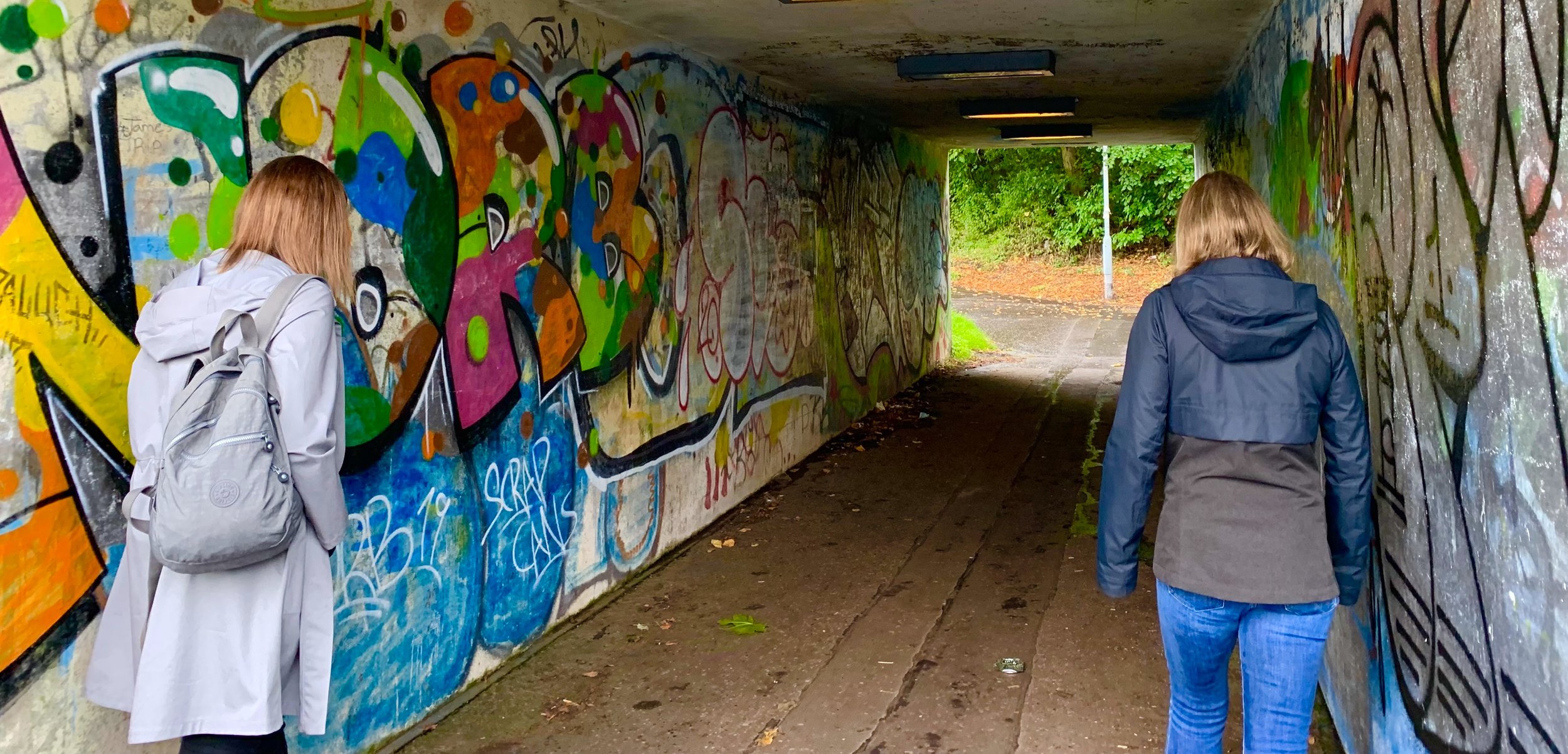Walking Interviews- All You Need to Know
Walking interviews are interviews conducted on the move. They involve a ‘trialogue’ between a researcher, one or more participants and the place they traverse. Walking and talking as a qualitative research method has deep roots in ethnography, anthropology, and geography, with researchers walking alongside participants to observe and experience their everyday practices.
“History begins at ground level, with footsteps”
Safety Audits Utilising Walking as a Method
In the beginning of 1990’s, a version of walking interviews was developed by the Metropolitan Toronto Action Committee on Violence Against Women and Children’s (METRAC) in Canada, as a tool for preventing urban violence as well as increasing women’s involvement in city governance. In a shape of safety audit, women walk through the spaces that they use observing and identifying factors such as inadequate or absent lighting or signage, disheartening graffiti messages, frightening passageways or overgrown bushes which make them feel unsafe. Walks sometimes take place with city officials, and a report is presented on completion to those responsible for safety in the city. From this point, it is hoped that the changes recommended are implemented and insecure areas become safer places to everyone in the community. The METRAC approach has since been broadened into a general tool to enable decisionmakers to gain ‘user knowledge’ about the city, and vice versa, for residents to pass their experiences on to the people in charge of urban design.
Walking Interviews Mapping the ‘Presency’ of Women in Cities
What if Women Designed the City?
My PhD explores how innovative ways of mapping both the presence and the agency of contemporary women in cities may support the emergence of emancipatory placemaking perspectives and previously unrecorded narratives.
From June to November 2021, I conducted 275 walking interviews with women in three Scottish cities: Perth, Edinburgh (Portobello and Wester Hailes) Glasgow (Drumchapel and Yorkhill & Kelvingrove).
I developed a ‘What if Women Design the City’ regenerative framework to gain a deeper understanding on their interdependent experience of sense of place, green spaces, active travel, and safety.
“How vain it is to sit down to write when you have not stood up to live!”
The walking interviews were participant driven: that is, participants selected the geographical location and the route for the interview. Some participants prepared in advance, while others took a stroll and made decisions on site. Women were notified that they were regarded as expert guides and the route they choose would enable the research to access their experiences and knowledge about the specific area. In the process of engaging with gatekeepers (essential mediators for accessing participants) and participants, I created 3 Principles and 1 Ground Rule for Walking Interviews.
Exploring how sidewalks are built, public transport networked, alleyways illuminated if designed by women
Walking Interview Principles
The Walking Interview has Three Principles and One Golden Rule.
The Three Principles state:
1. Women participants are the expert guides choosing the route they want;
2. Whenever the walk starts is the right time;
3. When it’s over, it’s over.
The Golden Rule:
Taking part in this interview is voluntary. Choosing not to take part will not disadvantage you in any way. You have the right and freedom to withdraw from the walk at any time without explanation.
Thus, participants made all the decisions, including the route to be followed, the length of time of the walking interview, and what they wanted to show. The shortest walk took 19 minutes and the longer 1 hour and 34’minutes with an average length of 1 hour. The area walked was marked at the end of each walking interview on most occasions by the participants themselves, in an app I have developed using ArcGIS platform. Audio data was recorded through audio software on a smart device and transcribed later, in the platform which support the analysis with graphs, maps, word clouds and thematic coding.
“Walking affirms, suspects, guesses, transgresses, respects, etc., the trajectories it ‘speaks’ ”
Exploring how cities of both the present and the future can be green, inclusive, liveable and poetic
Tips to Prepare for Walking Interviews
Here are some practical tips to prepare you for using walking interviews as a research method:
1-Risk Assessment
Needless to say, you need to develop and continually update your risk assessment, according to your university requirements and the latest of your National Health Authorities guidelines.
2-Reconnaissance of the Territory
Before beginning in earnest, the researcher needs to conduct reconnaissance walks by herself, checking busy roads and suitable crossing places. If you are doing a whole day of walking interviews, as I have done on many occasions, make sure you know where the public toilets are in the area. Also plan for breaks and be prepared to let go of your plan as your participant can take you to unforeseen areas.
3-Choose the Equipment
You may want to choose discreet and light equipment which can give your participant freedom and anonymity. In the beginning, I prepared a whole set of recording equipment, back-ups and battery charges all packed in a heavy backpack! As I reached equipment proficiency, I started to shed some of the layers of the recording kit and ended with a much lighter backpack. Start safer in terms of equipment then aim to simplify without compromising backups. And do not forget blank Consent Forms in case you did not get them signed in advance.
How technology can support women to gather, produce and navigate city data.
4- Weather-Proofing
Check the weather forecast and rearrange your walking interview if conditions do not permit safe walking. Being in Scotland, I timed the walks between Spring and Fall despite being determined to walk under rain, drizzle, and sunshine. Some may advise walkers to bring suitable clothing and items for the weather conditions, which I didn’t do, instead trusting women to be vigilant and discerning.
5-Go through your Questions
Whatever research method you decide to adopt make sure your questions are your second skin. By this I mean know them inside out as you may need to vary, adapt and change according to the circumstances; and while walking you may not have the chance to look at your app or notebook for the next line of enquiry.
6- Timing is everything
The participant is dedicating time for a research purpose that may interest her or not. Therefore, be there before your time to honour the commitment. In my 275 interviews I got late twice. My real lateness happened between the first and second interview- obviously! It took much longer than expected which I was terribly sorry and since then gave more breathing times in between the scheduled interviews.
How to shift from dominance to intimacy with the entity of place- walking interviews
“Walkers are ‘practitioners of the city,’ for the city is made to be walked.”
Walking Interviews have Many Benefits
There are multiple benefits related to walking interviews. The participant gets to show rather than describe the aspects of the environments that the research is interested in. Walking oxygenates the brain. Experiments have demonstrated that after or during exercise, even mild exertions, people perform better on tests of memory and attention. In this context, I witnessed women thinking aloud, exposing mental models to open air, and engaging in incremental theory building. The method can also create opportunities for the serendipitous and the unanticipated. Simple examples like speaking about urban equality and conditions of pavements and crossing with a father pushing a pram; or talking about large portions of a park as a statement of class, age and gender influence, and being bumped into by a runner representative of such influence; or even being silenced by loud engine roar while speaking about car-centred neighbourhoods.
I am on course to complete my PhD Research entitled What if Women Designed the City by fall 2022. Keep in touch if you want to read my discussions and recommendations.
May East






